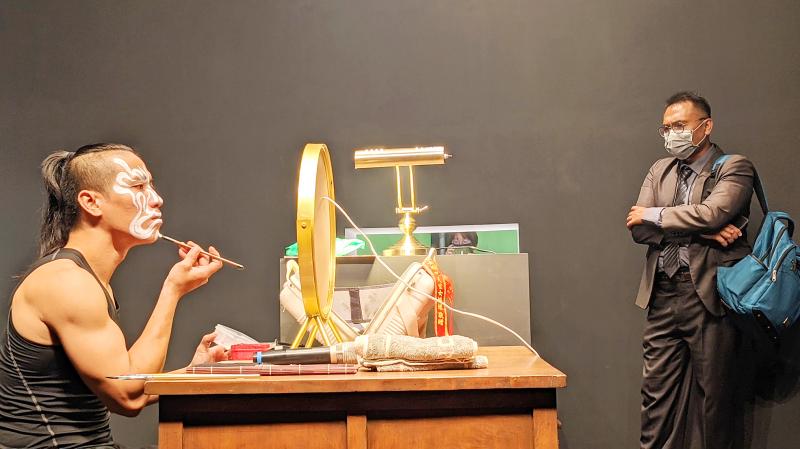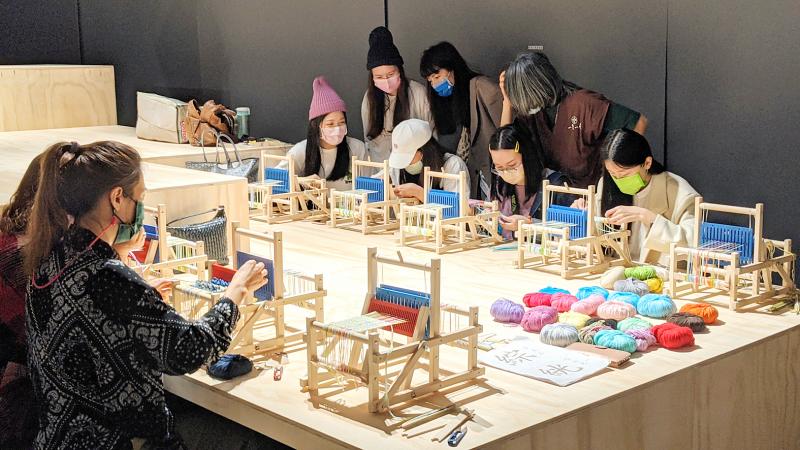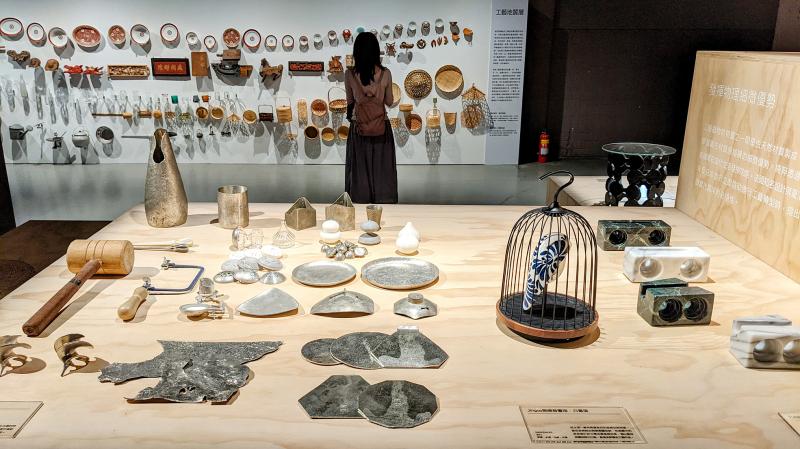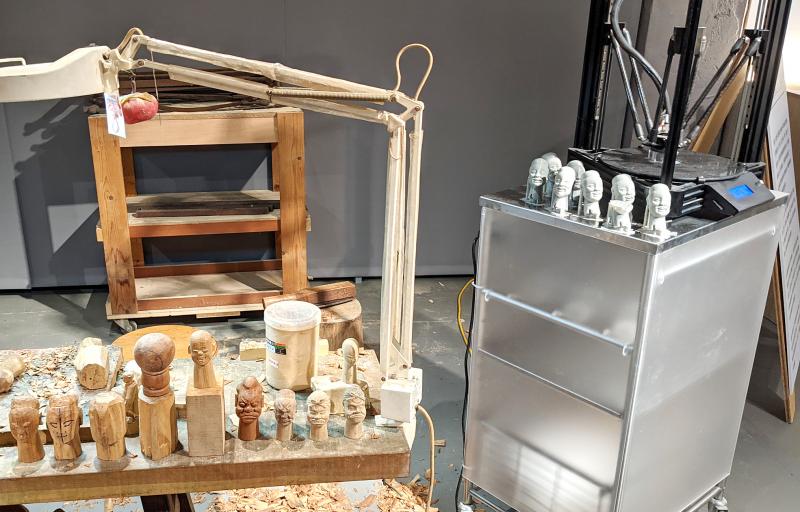Traditional hand puppet carver Lai Yung-ting (賴泳廷) is “competing” with a 3D printer this week in a sleek exhibition hall in downtown Taipei. Lai honed his craft from the age of 17 under the iconic master Lee Tien-lu (李天祿), and there’s no comparing the two even though the machine works precisely and tirelessly.
“This setup lets viewers experience first-hand the challenges that traditional crafts face in the real world,” the placard reads. Lai’s workshop is part of the Craft Land exhibition in the culture section of this year’s Creative Expo Taiwan, which runs until Sunday at several locations in Taipei.
Much of the culture section, located at Huashan 1914 Cultural Park, is overly abstract, focusing too much on artistic concepts instead of conveying information, and the expo overall is entirely geared towards Taiwanese audiences with little to no English translation throughout. But there’s still some intriguing takeaways, especially the emphasis on preserving traditional crafts and promoting sustainability.

Photo courtesy of Han Cheung, Taipei Times
The main hall, “Law of Beliefs,” dedicates its spacious first room to a Taiwanese-style talk show display, where two animated hosts banter incessantly to fancy lights and laser beams. It’s a questionable use of space and one has to be really attuned to local culture to understand what’s going on — being fluent in Mandarin isn’t enough. Meanwhile, viewers are supposed to interact with a chatty “guide” through Facebook messenger, but it keeps asking questions in a cutesy tone that bogs down the viewing experience. It’s supposed to get people thinking about the show’s concepts of self-belief, sharing and so on; perhaps it works for some.
In the next room, a guanjiangshou (官將首) temple troupe performer paints his face against a modern, minimalist backdrop to mostly young viewers sitting on mismatched vintage furniture. He talks about the long hours he put into honing his skills, and laments that few young people are willing to take up the mantle. This would have been a better opening to set the scene as traditional crafts are a significant part of this year’s offerings, especially the creative applications that can help them stay relevant.
A good proportion of sample products in the final room meld tradition with modern design and sustainability. For example, there’s an eco-friendly soap made using ancient techniques, lights made from disused wooden electric poles and stylish paper cut-outs of the Taoist deity Black Tiger General (黑虎將軍).

Photo: Han Cheung, Taipei Times
BRIDGING THE GAP
Craft Land takes the concept further: “Crafts are more than just copying the past, we must stand on the shoulder of giants and find the balance between manual and industrial techniques while continuing to offer solutions to the problems in everyday life.”
Industrial solutions are no longer enough as consumers look toward sustainability and regain an appreciation for handicrafts. There’s still a gap between the two sides, and the show explores ways to bridge it.

Photo: Han Cheung, Taipei Times
Products made from agricultural and industrial waste are already increasingly common; more intriguing are the designers that try to find a middle ground between the warmth of handcrafting and mass production or cutting-edge technology. This can be as simple as a wooden jewelry box whose intricate designs are mostly machine-printed, but the finishing touches are put on manually with lacquer painting and gold powder. Tradition becomes added value this way.
More conceptual are the ceramic wares whose clay formulas and firing time are determined by computer programming, jewelry that is 3D printed but finished with traditional lacquer techniques and recycled glassware that is machine made, but employs a natural technique that creates random patterns on each piece.
The theme continues in the design section, which opened on Wednesday at Songshan Cultural and Creative Park. It’s mostly an expo of interesting made-in-Taiwan goods, but it’s telling that the first hall opens to a display of Yingge pottery created through the Taiwan Design Research Institute’s T22 project, aimed to revive local industries by pairing them with modern designers.

Photo: Han Cheung, Taipei Times
There’s also a special zone for sustainable, recycled products, where I briefly chat with a vendor who has been making seed paper for about a decade. It’s getting easier each year to explain eco-friendly concepts to people, she says, but sustainability should be a lifestyle, not just a trend. That also rings true for the traditional crafts. There’s still not really a solution for young people not wanting to become hand puppet carvers, but it was encouraging to see more businesses trying to integrate time-honored elements into every-day products.

Anyone who has been to Alishan (阿里山) is familiar with the railroad there: one line comes up from Chiayi City past the sacred tree site, while another line goes up to the sunrise viewing platform at Zhushan (祝山). Of course, as a center of logging operations for over 60 years, Alishan did have more rail lines in the past. Are any of these still around? Are they easily accessible? Are they worth visiting? The answer to all three of these questions is emphatically: Yes! One of these lines ran from Alishan all the way up to the base of Jade Mountain. Its

The only geopolitical certainty is that massive change is coming. Three macro trends are only just starting to accelerate, forming a very disruptive background to an already unsettled future. One is that technological transformations exponentially more consequential and rapid than anything prior are in their infancy, and will play out like several simultaneous industrial revolutions. ROBOT REVOLUTION It is still early days, but impacts are starting to be felt. Just yesterday, this line appeared in an article: “To meet demands at Foxconn, factory planners are building physical AI-powered robotic factories with Omniverse and NVIDIA AI.” In other words, they used AI

Nov. 25 to Dec. 1 The Dutch had a choice: join the indigenous Siraya of Sinkan Village (in today’s Tainan) on a headhunting mission or risk losing them as believers. Missionaries George Candidus and Robert Junius relayed their request to the Dutch governor, emphasizing that if they aided the Sinkan, the news would spread and more local inhabitants would be willing to embrace Christianity. Led by Nicolaes Couckebacker, chief factor of the trading post in Formosa, the party set out in December 1630 south toward the Makatao village of Tampsui (by today’s Gaoping River in Pingtung County), whose warriors had taken the

The rhythms of bustling, working-class Mumbai are brought to vivid life in All We Imagine as Light. The stunning narrative debut of filmmaker Payal Kapadia explores the lives of three women in the city whose existence is mostly transit and work. Even that isn’t always enough to get by and pay the rent. One of the women, a widow, recently retired from working her whole life at a city hospital, Parvaty (Chhaya Kadam), is even facing eviction. The other two, roommates and co-workers in the maternity ward are in different parts of life. Prabha (Kani Kusruti) has a husband from an